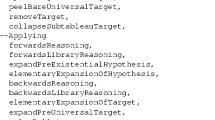Abstract
In a previous paper Todd (Submitted to AMAI, 2022), linear systems corresponding to sets of angle bisector conditions are analyzed. In a system which is not full rank, one bisector condition can be derived from the others. In that paper, we describe methods for finding such rank deficient linear systems. The vector angle bisector relationship may be interpreted geometrically in a number of ways: as an angle bisector, as a reflection, as an isosceles triangle, or as a circle chord. A rank deficient linear system may be interpreted as a geometry theorem by mapping each vector angle bisector relationship onto one of these geometrical representations. In Todd (Submitted to AMAI, 2022) we illustrate the step from linear system to geometry theorem with a number of by-hand constructed examples. In this paper, we present an algorithm which automatically generates a geometry theorem from a starting point of a linear system of the type identified in Todd (Submitted to AMAI, 2022). Both statement and diagram of the new theorem are generated by the algorithm. Our implementation creates a simple text description of the new theorem and utilizes the Mathematica GeometricScene to form a diagram.
Similar content being viewed by others
References
Todd, P.H.: Automated Discovery of Angle Theorems. Submitted to AMAI (2022)
Wen-Tsun, W.: Basic principles of mechanical theorem proving in elementary geometries. J. Autom. Reason. 2(3), 221–252 (1986). https://doi.org/10.1007/BF02328447
Kutzler, B., Stifter, S.: On the application of buchberger’s algorithm to automated geometry theorem proving. J. Symbol. Comput. 2(4), 389–397 (1986). https://doi.org/10.1016/S0747-7171(86)80006-2
Chou, S.-C.: Mechanical geometry theorem proving. Springer, Dordrecht (1988). https://doi.org/10.1007/978-94-009-4037-6
Chou, S.C., Gao, X.S., Zhang, J.: Machine proofs in geometry: automated production of readable proofs for geometry theorems. World Scientific, Singapore (1994)
Chou, S.-C., Gao, X.-S., Zhang, J.-Z.: Automated generation of readable proofs with geometric invariants. J. Autom. Reason. 17(3), 325–347 (1996). https://doi.org/10.1007/BF00283133
Botana, F., Hohenwarter, M., Janičić, P., Kovács, Z., Petrović, I., Recio, T., Weitzhofer, S.: Automated theorem proving in geogebra: current achievements. J. Autom. Reason. 55(1), 39–59 (2015). https://doi.org/10.1007/s10817-015-9326-4
Kovács, Z.: Discovering geometry theorems in regular polygons. In: International conference on artificial intelligence and symbolic computation, pp. 155–169. Springer (2018)
Botana, F., Kovács, Z., Recio, T.: Towards an automated geometer. In: International conference on artificial intelligence and symbolic computation, pp. 215–220. Springer (2018)
Kovács, Z., Recio Muñiz, T., Vélez, M.P., et al.: Using automated reasoning tools in geogebra in the teaching and learning of proving in geometry. (2018)
Botana, F., Kovács, Z., Recio, T.: A mechanical geometer. Math. Comput. Sci. 15(4), 631–641 (2021). https://doi.org/10.1007/s11786-020-00497-7
Hohenwarter, M., Kovács, Z., Recio, T.: Using automated reasoning tools to explore geometric statements and conjectures. In: Proof Technology in Mathematics Research and Teaching, pp. 215–236. Springer, (2019)
Yang, L., Hou, X., Xia, B.: A complete algorithm for automated discovering of a class of inequality-type theorems. Sci. China Ser. F. Inf. Sci. 44(1), 33–49 (2001)
Brown, C.W., Kovács, Z., Vajda, R.: Supporting proving and discovering geometric inequalities in geogebra by using tarski. arXiv:2201.00544 (2022)
Todd, P.: Geometry expressions: a constraint based interactive symbolic geometry system. In: International Workshop on Automated Deduction in Geometry, pp. 189–202. Springer (2006). https://doi.org/10.1007/978-3-540-77356-6_12
Todd, P.H.: Looking forward to interactive symbolic geometry. Understanding Geometry for a Changing World. 71st Yearbook. Reston, VA: The National Council of Teachers of Mathematics, Inc, 349–365 (2009)
Todd, P.: A symbolic dynamic geometry system using the analytical geometry method. Math. Comput. Sci. 14(4), 693–726 (2020). https://doi.org/10.1007/s11786-020-00490-0
Saunders, B.D.: Matrices with two nonzero entries per row. In: Proceedings of the 2015 ACM on International Symposium on Symbolic and Algebraic Computation, pp. 323–330 (2015)
Todd, P.H., Robben, N., Vassilev, A.: Rank Deficient Bisector Matrices with Underlying Graphs, Saltire Technical Report 22-2 (2022). http://saltire.com/downloads/TR222
Wolfram Research Inc: Mathematica, Version 13.1. Champaign, IL, 2022 (2022). https://www.wolfram.com/mathematica
Daniel, M.: Automated Drawings, Conjectures, and Proofs in Planar Geometry. Paper presented at CADGME 2018, University of Coimbra, Portugal, 25-29 June 2018 (2018)
Todd, P.H.: Automatically generated angle theorems, Saltire Technical Report 22-1 (2022). http://saltire.com/downloads/TR221
Todd, P.H., Aley, D.: Random Theorem Generator - Mathematica Notebook (2022). http://saltire.com/downloads/randomTheoremGenerator.nb
Wolfram Research Inc.: Wolfram player. https://www.wolfram.com/player/
Author information
Authors and Affiliations
Contributions
Equal contribution
Corresponding author
Ethics declarations
Conflicts of interest
The authors declare that they have no conflict of interest.
Additional information
Publisher's Note
Springer Nature remains neutral with regard to jurisdictional claims in published maps and institutional affiliations.
Rights and permissions
Springer Nature or its licensor (e.g. a society or other partner) holds exclusive rights to this article under a publishing agreement with the author(s) or other rightsholder(s); author self-archiving of the accepted manuscript version of this article is solely governed by the terms of such publishing agreement and applicable law.
About this article
Cite this article
Todd, P., Aley, D. A program to create new geometry proof problems. Ann Math Artif Intell 91, 779–795 (2023). https://doi.org/10.1007/s10472-023-09854-1
Accepted:
Published:
Issue Date:
DOI: https://doi.org/10.1007/s10472-023-09854-1




